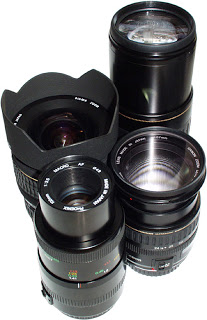
Previously I explained why I think having an expensive camera body isn’t necessary. On the other hand, you should buy the best lenses you can afford simply because your lenses will outlast your camera body and can make a big difference to image quality. You will benefit from technology improvements in the camera body as you upgrade and so it just makes sense to be using the best lenses that you can afford and that are aligned with your own shooting requirements from the get go.
First though a primer on lenses. Essentially, there are two main types, prime and zooms. Primes are lenses of a fixed focal length whereas zooms have a variable focal length. Purists prefer primes for a range of reasons, mainly “sharpness” and speed. Here speed refers to the aperture, the ability of the lens to let in light. A fast lens may have an aperture of f2.8 or more (smaller number, bigger hole = more light = faster = bigger aperture). A fast lens can be an asset in low light but then you can nearly always use a flash anyway. Fast primes tend to be specialist tools and can be expensive.
Zooms are a better proposition for enthusiast photographers because you have a range of focal lengths available at your command in a single package. If you can’t get close, zoom in. If you need to shoot a group, go wide. Excellent. However, the zoom lens is not a master of a single focal length like the prime. Also a fast constant aperture zoom is going to be huge and expensive. Chances are you don’t need the deluxe model anyway so don’t worry too much about it.
Specialty macro lenses are typically fast primes that can create an image at up to 1:1 which is to say lifesize on the sensor for detailed closeups. Many modern lenses will say “macro” on them or suggest they have a macro capability. This refers to their ability to focus fairly closely, not their ability to fill an image frame at 1:1. So they may be OK for closeups but not true macro photography, an important distinction.
So what about focal length then? The link has some confusing maths and a technical explanation but in simple terms its the distance expressed in mm from the lens to the sensor plane. The smaller it is the wider the image you can capture. The bigger it is the further you can see. For example a 16mm lens focal length offers wide angle shooting whereas 300mm is a useful telezoom focal length for shoot birds and such. This link shows what the same scene looks like at different focal lengths.
For most of us shooting with APS-C sized sensors in our camera, it’s important to understand a few things. First, APS-C refers to the size of the sensor, 25.1 × 16.7mm which is smaller than a 35mm sensor. Obviously with a smaller frame it fits well inside the image circle of a 35mm lens which is what the lens and camera systems were originally designed for. This leads to the myth of 35mm equivalence in lens descriptions where lets say a lens of 300mm focal length is then said to be the equivalent of 450mm. It’s not. The focal length remains the same but the field of view certainly changes. Again some more complex math in the link, but some useful images as well to help explain. Anyway what this means is when you go to buy a lens, don’t be sucked in to thinking you have greater focal length because of the crop factor. You don’t. A 300mm lens is always going to have a focal length of 300mm, only the field of view changes.
Moving on, lenses come in about 3 grades of quality and performance. First kit lenses. These are the ones supplied with your camera when you buy it. You may get one covering the most useful focal lengths or two which together cover from about 28-300mm. These are usually plastic in construction with simple optical designs. They are not especially fast but for casual photographers are going to be perfectly adequate for most situations. The next step up are lenses which have better construction and superior optical design. They may not be particularly fast but will often suit the discerning enthusiast photographer. Finally there is the professional lens. These are fast, built like tanks to take the hammering of being used all day every day and are big and heavy as a result. They may have many buttons and switches to provide a high level of control. Needless to say they are expensive.
Which should you buy? If you have deep pockets, must have the best and have a strong back then clearly the pro lenses are for you. In some applications such as shooting birds and sport, it makes perfect sense to buy the best lens. However its not essential. My view is that once you understand the limitations of your kit lenses, consider the mid range offerings unless you have an application that absolutely requires a specialist lens. I am using the Sony 16-105 and find it meets my requirements as a useful general purpose lens quite nicely. It is certainly better than the lens it replaced, has a useful range of focal lengths and is small and light making it convenient and unobtrusive to use. I am using the Minolta 100-300 APO for longer focal lengths and it has proven to be an excellent workhorse and again light and unobtrusive. When you travel you will understand why “light and unobtrusive” are significant factors. The APO coatings deal with a problem of cheaper lenses, purple fringing which is the reason I bought it to replace the kit lens. Anyway with just these two lenses the bulk of shooting situations are covered and together these lenses represent an investment of much less than $1000-00 when I bought them. Second hand you can grab these lenses now for under $500-00. Your requirements may vary, but this approach works pretty well for me.
Some lenses from the film era like Minolta’s Alpha mount lenses will work on what are now Sony Alpha A mount DSLR cameras and E mount cameras as well with an adapter. While image quality can be good under ideal conditions it is worth noting older lenses can present issues. For example, modern lenses have sophisticated coatings not found on older lenses to combat CA and sensor reflections. Under certain conditions flare, ghosting and purple fringing may be evident, issues much better controlled in modern lenses. So while the old lenses are beautiful to behold and can produce magnificent images, be aware of their potential limitations. On top of this the original AF Minolta lenses have metal bodies making them very heavy and less than ideal for carrying on your back all day. Additionally, older lenses may be infested with fungus which attacks the glass and coatings and can be transferred to other lenses. Buying a lens with fungus is not something you want to have happen to you. Keep these things in mind when you contemplate acquiring an older second hand lens.
Finally, a topic that rages endlessly on internet photography discussions is the subject of sharpness. Unless you have a badly aligned or defective lens ultimate sharpness doesn’t matter which is why I didn’t think it important to discuss. Click here to read more.





